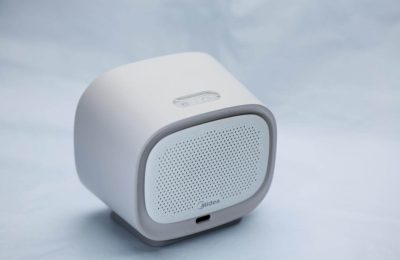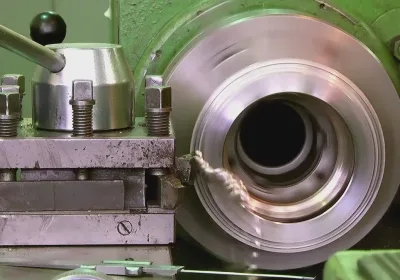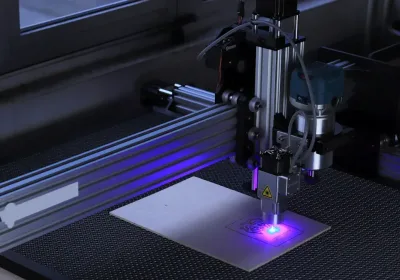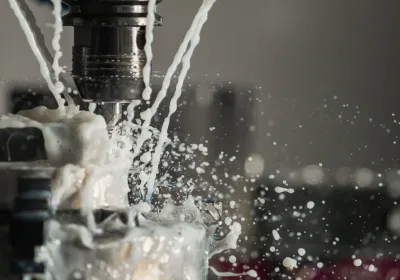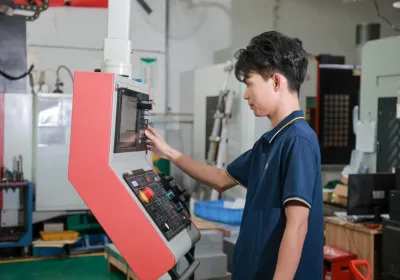
Choosing the best CNC router machinery is important for your business. It affects how fast, accurate, and affordable your work is. New technology makes CNC router machinery essential for modern manufacturing. Here’s why:
CNC router machinery is growing popular because it is precise and reliable.
Businesses using CNC router machinery see better productivity and lower costs.
Smart features make CNC router machinery flexible for many different tasks.
Knowing about CNC router machinery helps you pick the right one. This saves time and boosts profits.
Key Takeaways
Picking the right CNC router helps save time and money. Think about what your business needs to choose the best one.
Learn about the types of CNC routers. Each type works for different jobs, like simple woodwork or detailed designs.
Taking care of CNC routers is very important. Clean them, oil them, and check for problems to keep them working well.
Choose a CNC router that fits your materials and space. This makes your projects easier and faster to complete.
Get good CAD/CAM software for your CNC router. It improves accuracy and makes designing and cutting simpler.
Types of CNC Router Machinery
Knowing the types of CNC routers helps you choose wisely. Each type has special features for specific jobs. Let’s look at the most common CNC router types and their uses.
3-Axis CNC Routers: Features and Uses
A 3-axis CNC router is simple and widely used. It moves in three directions—X, Y, and Z. This lets it cut, carve, and engrave materials accurately. These machines work best on flat or slightly curved surfaces. They are great for woodworking, sign-making, and basic machining.
Key Features:
Easy to use with a simple design.
Cuts wood, plastic, and soft metals.
Affordable for small to medium businesses.
You can use 3-axis CNC routers to make furniture, cabinets, and panels. Their low cost and flexibility make them ideal for beginners in CNC machining.
4-Axis CNC Routers: Features and Uses
A 4-axis CNC router adds rotation to the 3-axis machine. This extra axis, called the A-axis, helps with round or odd-shaped objects. If your work needs detailed designs or complex shapes, a 4-axis CNC router is very helpful.
Uses:
Making detailed carvings and sculptures.
Shaping chair legs, table bases, and round parts.
Engraving on pipes or columns.
With a 4-axis CNC router, you can work faster and more precisely. It’s perfect for woodworking and custom projects needing multi-dimensional work.
5-Axis CNC Routers: Features and Uses
A 5-axis CNC router is the most advanced type. It moves in five directions, allowing for very detailed and complex designs. These machines are crucial for industries like aerospace, automotive, and high-tech manufacturing.
Advantages:
Makes complex parts in one setup.
Saves time by reducing manual adjustments.
Works with many materials like metals and plastics.
For example, car makers use 5-axis CNC routers for precise parts. Aerospace companies use them for lightweight, strong components. Though expensive, their advanced features are vital for industrial tasks.
Tip: If your business needs precise or complex designs, a 5-axis CNC router can help you stay ahead of competitors.
Specialized CNC Router Machines for Specific Needs
Not all CNC routers work for every business. Some industries need special CNC machines for unique tasks. These machines do things that regular ones cannot. If your business has specific jobs, a specialized CNC router can save time and improve quality.
CNC Routers for Sign-Making and Engraving
Sign-making needs machines that handle detailed designs well. Special CNC routers for engraving are fast and precise. They work with materials like wood, acrylic, and aluminum. These machines often have tools for sharp edges and smooth finishes.
Benefits:
Make clear letters and logos.
Handle small jobs with steady results.
Cut materials precisely to avoid waste.
Tip: For signage or engraving, pick CNC routers with fast spindles and design-friendly software.
CNC Routers for Foam and Composite Materials
Foam and composites need special cutting tools. CNC routers for these materials prevent rough edges or tears. These machines are great for packaging, cars, and planes.
Applications:
Make molds and test models.
Cut light parts for vehicles or planes.
Create custom packaging designs.
Using the right machine for foam and composites reduces mistakes and works smoothly.
CNC Routers for Stone and Glass
Cutting stone and glass needs strong machines. Special CNC routers for these materials have sturdy frames and water-cooled spindles. They are great for countertops, tiles, and artistic designs.
Key Features:
Strong enough for hard materials.
Use water jets or diamond tools for accuracy.
Less vibration for better finishes.
These machines are perfect for construction, design, and art businesses.
CNC Routers for Multi-Material Applications
Some businesses need machines for different materials. Multi-material CNC routers can cut wood, metal, plastic, and more. They combine features from other CNC machines for flexibility.
Advantages:
Switch materials without changing tools often.
Save time with automatic settings.
Do many projects with one machine.
Note: Multi-material CNC routers are great for businesses with changing needs.
Special CNC routers help meet specific business goals. Picking the right one improves quality and keeps you competitive.
Key Parts of CNC Router Machines
Knowing the main parts of CNC machines is important. Each part helps the machine cut quickly and accurately.
Spindles: Why They Matter
The spindle is the most important part of a CNC router. It spins the cutting tool very fast to make clean cuts. A good spindle works smoothly and reduces shaking. When picking a CNC router, think about spindle power and speed. For example, cutting wood needs less power, but cutting metal needs more power.
Tip: Take care of the spindle to avoid overheating and keep it working well.
Motors: Comparing Stepper and Servo Motors
Motors move the parts of a CNC router. This affects how precise and accurate the machine is. The two main types of motors are stepper motors and servo motors.
Feature | Stepper Motors | Servo Motors |
|---|---|---|
Precision | Good for small steps; may miss some steps. | Very accurate with feedback for precision. |
Speed & Power | Strong at low speeds; slower overall. | Strong and fast at all speeds. |
Cost | Cheaper and simpler to use. | More expensive but lasts longer. |
Control System | Easy to set up but less advanced. | Advanced system; harder to set up. |
Energy Use | Uses full power all the time. | Saves energy by adjusting power. |
Durability | Simple and tough; can get hot. | Reliable but needs regular care. |
Best Use | Great for hobbies or simple tasks. | Best for fast and precise work. |
If you need high speed and accuracy, go with servo motors. For easy and affordable projects, stepper motors are a good choice.
Control Systems: Keeping Things Accurate
Control systems act like the brain of CNC machines. They guide the spindle and motors to make precise cuts. Advanced systems improve quality with features like automatic tool changers.
Calibration: Matches the machine to the design to avoid mistakes.
Care: Regular maintenance keeps the system running well.
Setup: Securing materials properly prevents cutting errors.
Environment: Temperature and humidity can change material behavior.
Skill: Experienced operators make better adjustments for accuracy.
Note: A good control system improves precision and reduces machine downtime.
Frames, Gantries, and Structural Stability
The frame and gantry are very important parts of a CNC router. They affect how steady and accurate the machine works. A strong frame reduces shaking, making cuts smoother and more precise. When picking a CNC router, check the frame's material and quality. Steel frames are strong and firm, while aluminum frames are lighter and easier to move.
The gantry holds the cutting tool and keeps it steady. A good gantry helps the tool move smoothly across the workspace. Look for machines with strong gantries, especially if you work with heavy materials. Weak gantries can cause uneven cuts and slow down your work.
The machine's design also affects its stability. Machines with a low center of gravity stay steady during use. Adjustable feet can help balance the machine on uneven floors. For big projects, choose CNC routers with extra-strong frames and gantries to handle the load.
Tip: Check the frame and gantry for damage often. Taking care of them can make them last longer.
Tooling Options for Various Applications
The tools you use with your CNC router decide what it can do. Different jobs need different tools for the best results. For woodworking, use tools like straight bits, V-bits, or ball nose bits. These tools help make detailed designs and smooth surfaces. For metalworking, end mills and drill bits are needed. They cut through hard materials accurately.
If you work with many materials, get a CNC router with an automatic tool changer. This feature switches tools automatically, saving time and effort. You can also find special tools for tasks like engraving or 3D carving.
Taking care of your tools is very important. Worn-out tools can ruin your work. Keep tools clean and dry, and replace them when needed.
Note: Using the right tools for your CNC router improves results and reduces waste.
Selection Criteria for CNC Router Machinery
Picking the right CNC router for your business is important. You need to think about several key factors. These help ensure the machine fits your needs and works well. Let’s look at what to consider.
Material Compatibility and Versatility
The materials a CNC router can handle are very important. Different industries need machines for specific materials. For example, woodworking uses CNC routers for furniture, while aerospace needs them for precise parts. A flexible machine can work with wood, metal, plastic, and more. This helps your business take on different projects.
Industry | Common Uses |
|---|---|
Furniture Making | Cabinets, custom furniture, wood carvings |
Advertising & Signage | Acrylic letters, PVC signs, aluminum boards |
Mold Making | Prototype molds, small-batch production |
DIY & Craft | Home decor, gifts, hobby projects |
Education | Training, practical demonstrations |
Aerospace & Automotive | Precision parts, interior trim, composites |

Modern CNC routers can now cut advanced materials like alloys and polymers. This flexibility is great for businesses wanting to offer more products. Many companies also focus on eco-friendly materials and methods to stay sustainable.
Tip: Pick a CNC router that works with your main materials. A flexible machine can help you grow your business later.
Workspace Size and Machine Footprint
Your workspace size matters when choosing a CNC router. Machines come in many sizes, from small ones for tight spaces to big ones for large jobs. Measure your space before buying. Make sure there’s room for the machine and maintenance.
Small CNC routers are good for hobbyists or small shops. They are easy to move and set up. Bigger machines are better for large projects like cabinets or signs. But they need more space and good ventilation to work well.
Note: Leave extra room for storing materials, moving around, and safety zones.
Production Volume and Speed Requirements
How much and how fast you need to produce affects your choice. Fast CNC routers are great for industries like aerospace and automotive. These machines handle big jobs quickly and accurately. They are worth it for businesses with high demand.
The CNC router market is growing because businesses need speed and precision. Faster machines save time and keep quality high. For smaller jobs or custom work, slower machines can still do a good job and cost less.
Tip: Think about your current and future needs. A faster machine can help your business grow over time.
Budget and Cost-Effectiveness
Your budget is very important when picking a CNC router. You need to match the machine's price with its features and long-term benefits. Spending more upfront may seem hard, but it often means better performance and fewer repairs later.
Things That Affect Cost:
Machine Type: Fancy CNC machines, like 5-axis ones, cost more than simple 3-axis models. But they are more precise and flexible.
Size and Capacity: Bigger machines with large workspaces cost extra. They are great for businesses doing big projects.
Features and Add-ons: Tools like automatic changers and strong spindles raise the price. These features save time and effort.
Brand and Quality: Well-known brands charge more, but their machines last longer and work better.
Tips to Save Money:
Know Your Needs: Don’t pay for features you won’t use. For example, if you only cut wood, a 3-axis CNC router might be enough.
Buy Used Machines: Second-hand CNC routers can cost less. Check their condition and if support is available.
Think Long-Term: Cheaper machines may need more repairs. Spending more on quality equipment saves money over time.
Tip: Look at different options before buying. Picking the right CNC router gives you the best value for your money.
Maintenance and Long-Term Support
Taking care of your CNC router keeps it working well. Regular maintenance makes the machine last longer and perform better.
How to Maintain Your Machine:
Clean Daily: Remove dust and dirt after each use. This keeps the machine accurate.
Lubricate Parts: Add oil to moving parts often. This stops them from wearing out.
Check for Damage: Look at spindles, motors, and tools for problems. Replace broken parts quickly.
Update Software: Keep the control system updated. This fixes bugs and improves how the machine works.
Why Support Matters:
When buying a CNC router, check if the company offers help. Good manufacturers provide:
Expert Help: Talk to specialists who can solve problems.
Spare Parts: Easy access to replacement parts to avoid delays.
Training: Lessons to teach operators how to use the machine properly.
Note: Skipping maintenance can lead to expensive repairs and lower productivity. Follow a schedule to prevent breakdowns.
Managing Maintenance Costs:
Maintenance takes time and money but costs less than big repairs. Buying a service plan from the manufacturer can make this easier. These plans include regular checks and quick support.
Callout: A cared-for CNC router works better and keeps its resale value. This is one of the pros and cons of CNC machines to think about.
Software and Control Systems in CNC Routers
Why CAD/CAM Software Matters
CAD/CAM software is key for running CNC routers. It connects your designs to the machine, helping it work smoothly. Good software improves accuracy, speed, and workflow, making your products better.
Metric | Benefits of Good CAM Software |
|---|---|
Makes CNC operations faster and smoother | |
Features | Adds advanced tools for better results |
Updates | Keeps software current with new improvements |
Advanced CAD/CAM software has smart features like automatic toolpath creation and material saving. These tools cut down mistakes and save time. Regular updates keep your system ready for new tech, ensuring it stays useful.
Tip: Get trusted CAD/CAM software to boost your CNC router's performance and improve your work quality.
Easy-to-Use Interfaces for Operators
Simple interfaces make CNC routers easier to use. They help operators control the machine without confusion. Clear designs shorten training time, so new users learn faster.
Modern interfaces often have touchscreens, helpful visuals, and settings you can adjust. These features let operators track progress and fix issues quickly. For example, real-time updates help make accurate cuts and reduce waste.
Callout: Pick a CNC router with controls that match your team's skills. This helps avoid mistakes and increases efficiency.
Compatibility and System Integration
Compatibility ensures your CNC router works well with other tools and software. Integrated systems make workflows easier, saving time and boosting productivity.
Before buying, check if the machine works with your current CAD/CAM software and equipment. Compatible systems avoid expensive upgrades and keep things running smoothly. Machines with open designs can connect to other tools, giving you more options.
Note: A compatible system saves effort and helps your business handle new challenges easily.
Applications of CNC Router Machines in Industries
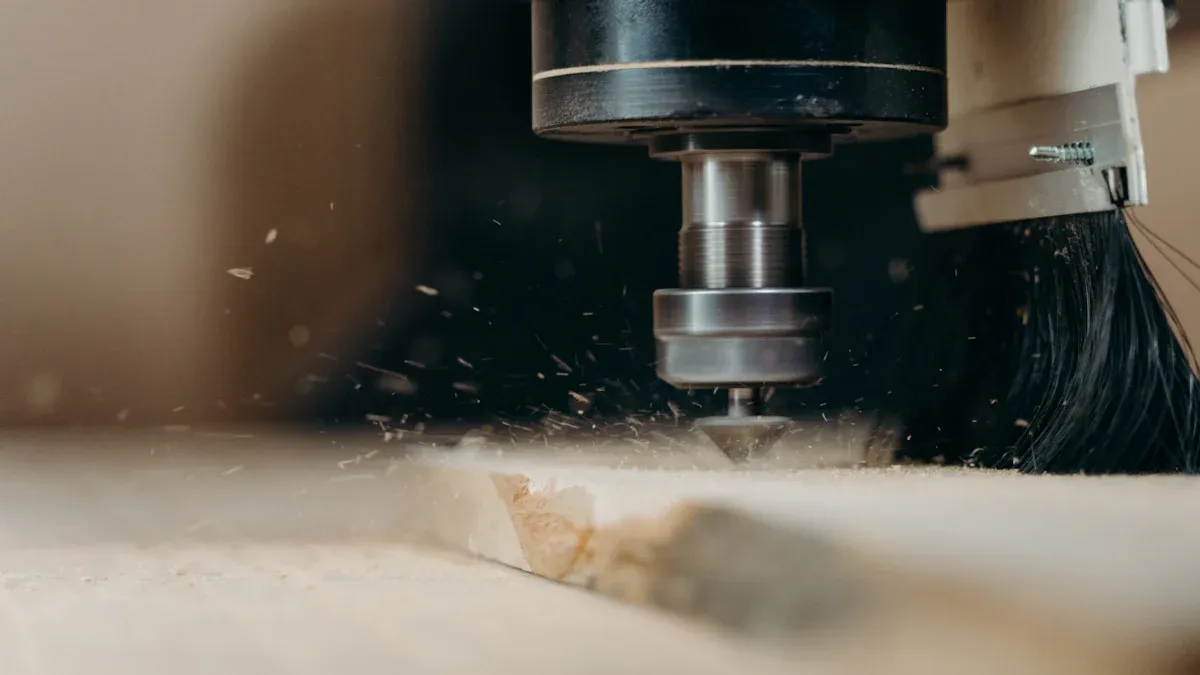
CNC Routers for Woodworking
CNC routers are very useful in woodworking. They help make detailed designs, cut shapes, and give smooth finishes. These machines are great for making furniture, cabinets, and decorations. They save materials and ensure every piece looks the same.
CNC routers are known for their accuracy and speed in woodworking.
The CNC router market was worth $691.02 million in 2023. It may grow to $869.26 million by 2031, with a 3.21% yearly growth rate.
Router bits are popular because they can carve, engrave, and shape.
New tool coatings and materials make CNC routers last longer and cut better.
If you work with wood, a CNC router can make your job easier. It helps you produce more items while keeping the quality high.
CNC Routers for Metal Fabrication
Metalwork needs exact cuts, and CNC routers are perfect for this. They can cut, engrave, and shape metals like steel, aluminum, and brass. These machines are used in industries like cars, airplanes, and building construction.
Feature | Benefit |
|---|---|
Advanced Control Systems | Adjusts quickly for accurate cuts. |
Multi-Axis Machining | Handles complex shapes without moving the material often. |
CAD/CAM Software Integration | Makes design-to-cutting faster and easier. |
Automatic Tool Changers | Switches tools quickly to save time. |
High-Speed Cutting | Cuts faster without losing accuracy. |
Strong Machine Frames | Reduces shaking for better results. |
Real-Time Monitoring | Tracks performance to fix issues early. |
Consistent Results | Makes identical parts every time. |
Smooth Finishes | Reduces extra work after cutting. |
Material Saving | Uses materials wisely to lower costs. |
These features make CNC routers essential for metalwork. They improve accuracy, save materials, and reduce costs.
CNC Routers for Plastic and Composite Materials
CNC routers are great for cutting plastics and composites. They work well with materials like acrylic, PVC, and carbon fiber. These machines are used in industries like signs, packaging, and airplanes.
They are used in many fields, like woodworking, signs, and aerospace.
Their flexibility helps businesses work faster and better.
They keep operations precise and high-quality across different tasks.
For example, in sign-making, CNC routers cut clean edges on acrylic letters. In aerospace, they shape lightweight materials for planes. Their versatility makes them a smart choice for many projects.
Multi-Material Applications and Versatility
A CNC router made for multi-material use is very flexible. It can cut wood, metal, plastic, and composite materials. This makes it perfect for businesses with different projects or materials.
These machines are useful in industries like furniture, cars, and airplanes. For example, one CNC router can cut wooden parts in the morning. Later, it can shape aluminum pieces in the afternoon. This saves time and keeps work moving smoothly.
Benefits of Multi-Material CNC Routers:
Cost Efficiency: One machine does many jobs, so you save money.
Time-Saving: Tool changers switch materials fast, saving effort.
Precision Across Materials: Control systems make accurate cuts every time.
Tip: Pick a CNC router with settings for speed and cutting depth. These features help you get the best results for each material.
Multi-material CNC routers are great for real-world tasks. They are used in prototyping to test designs on different materials. They also work well for custom jobs needing unique products.
When choosing a machine, think about your main materials and future plans. A flexible CNC router helps with today’s needs and prepares your business to grow.
Picking the right CNC router is key to your business's success. Knowing the types, parts, and features helps you choose wisely. This ensures the machine fits your needs, whether you work with wood, metal, or other materials.
A smart choice brings lasting benefits. CNC routers boost accuracy and make scaling up easier. They help you switch from small projects to bigger production smoothly. These machines also cut down on wasted materials, saving money and time. As industries like aerospace and cars need advanced tools, the right CNC router can help your business grow.
Think about your materials, workload, and budget carefully. Talk to experts, compare machines, and pick one that’s reliable and worth the cost. A good CNC router will meet your needs now and help you succeed in the future.
FAQ
How long does a CNC router last?
A CNC router can last 10-15 years with good care. Clean it often, oil moving parts, and replace worn-out pieces to make it last longer.
Can CNC routers cut different materials?
Yes, CNC routers can cut wood, metal, plastic, and composites. Machines that handle many materials are great for businesses with varied projects.
How do you take care of a CNC router?
Clean the machine every day to remove dust. Oil the moving parts regularly and check for damage. Update the software to keep it running smoothly.
Are CNC routers good for small businesses?
Yes, small CNC routers are cheap and fit in small spaces. They are perfect for custom jobs, testing designs, and small production tasks.
What safety rules should you follow with CNC routers?
Wear goggles and gloves to stay safe. Keep the area clean and follow the maker’s instructions to avoid accidents.
 LKprototype
LKprototype

